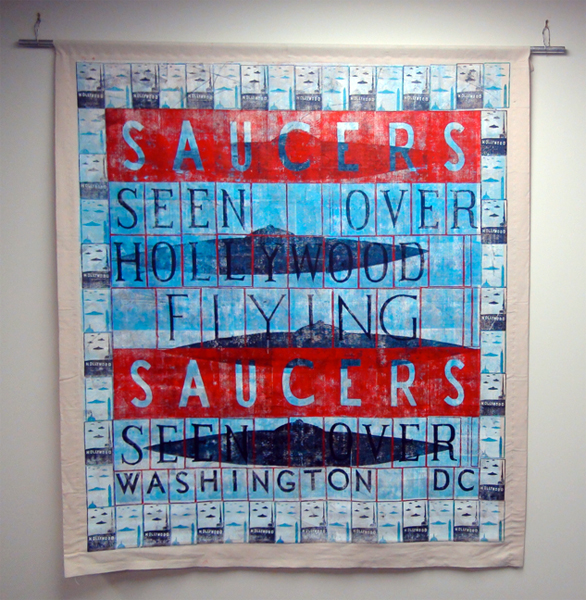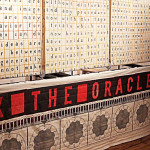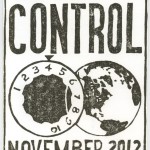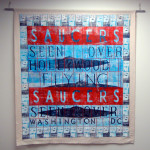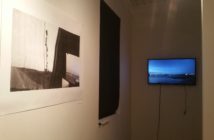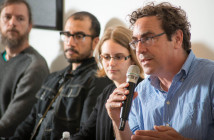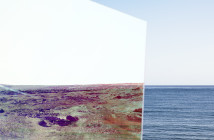It all hangs together in Mitchel K. Ahern’s installation, Welcome to Control, the November show at the Atlantic Works gallery in East Boston. But what’s it all hanging from? That question will haunt viewers to this exhibition billed as a "visitor center and gift shop to a secret culture management organization." Ahern’s typographic linocut monoprints on fabric are meant to raise questions instead of yield answers. Smiling and gnomic, they are the facets of a singular institutional entity; we look, and something looks back — Control. But do we want Control, or do we want to lose Control? Are they the good guys or the bad guys?
Saucers Seen Over Hollywood teases the viewer with the prospect of coordinates. One of several large prints on canvas featured in the show, it layers the silhouettes of iconographic flying saucers and B-movie headlines in arrested spin over the classic outlines of the Hollywood hills and the Washington Monument. Here the grid pattern that prevails throughout Ahern’s work balances the flush of a red alert and the calm of a deepening nightfall, recoding an earth-shattering encounter as souvenir postcards.
Another of Ahern’s large canvas prints, Martha Stewart Living Omni Media, slyly suggests that Control’s reach from government to popular culture penetrates our homes as well. The print’s pink, yellow, and aqua — cheeriness bleeding into paranoid psychosis — might be the colors of Stewart’s oven mitt holding up a pan of cookies in the graphic-novel style triptych that unscrolls at top and bottom, while another of the triptych’s panels features the domestic goddess’s mug shot. From there it’s only a small step to seeing the Department of Homeland Security canvas on the adjacent wall as the Control version of an old-fashioned sampler.
The domestic undercurrents continue in Ahern’s choice of support base for the series of smaller prints that hang between the large pieces — dishtowels. Unlike the usual Bed Bath & Beyond commodity, however, each of these dishtowels bears the grey ghost of the Control logo, a fluted tuning knob on an analog dial set within the omnipresent grid. These are stamped with the typographic conundrums of Control: Would you like to join Control? The world seems beyond our Control . . . Likenesses from the realms of politics and entertainment accompany these utterances, from Obama and Romney to Michael J. Fox and Willie Nelson. The heroes of the 1960s television series Get Smart make an appearance as well, and along with the larger canvas print, KAOS/CONTROL, they give viewers an obvious yet tongue-in-cheek reference point for the institution in charge of the visitors center.
But the presence of Brion Gysin and William Burroughs among the cast of dishtowel characters suggests a deeper, more comprehensive Control. Over several decades of the last century the artist Gysin and author Burroughs explored the radical possibility that language itself might be an alien imposition and instrument of control, and together they collaborated on a number of tools for the liberation of consciousness. Two of these, as it happens, are among Ahern’s interactive exhibits at Welcome to Control. The Cut-Up Desk provides visitors with the means to make their own Control manipulations (out of, amusingly, glossy magazines such as Artforum), while a booth in another corner contains a working Dream Machine. "Viewed" with eyes closed, this kinetic wonder makes flicker art out of viewers’ own firing neurons, allowing them to investigate the reaches of Control into inner space. But the question remains, why would Control put the tools for a jailbreak at our disposal?
Visitors can take their questions to exhibition’s centerpiece, the Scrolling Cut-Up Oracle of Control, which incorporates Ahern’s print-fabric art into a large loom-like machine. A handle revolves three canvas scrolls of different lengths, each scroll featuring cut-up text from a different source — William Burroughs, British-spy-turned-advertising-guru David Ogilvy, and an academic article on computational linguistics. But the warp of the aleatory and the woof of determinism combine to weave only inscrutable answers, requiring further divination: Something an / is embedded within / sexual frenzy; There are many / without disturbing / loud boom-boom; Simple ideas are / trials which use / Shell Gasoline. The Oracle heightens the ambiguity that animates this whole installation.
Welcome to Control takes visitors to a potentially over-familiar terrain — the fusion of the visual languages of entertainment, advertising, and propaganda — and manages to make it new. It does so, however, by acknowledging that terrain as historical, threatened with obsolescence and perhaps already a relic. Most obviously this occurs in the retro imagery — Get Smart, flying saucers, the tuning knob from a low-budget 50s sci-fi control panel. But even more so, it’s the materials and treatment that gesture towards a redemptive transience. Ahern, a "fiber performance artist" with a DIY aesthetic, eschews the glossy finish of postmodernism’s infinite reproducibility, instead rendering scratchy surfaces in thread-counts that would drive Martha Stewart batty. His hand-cut fonts of mixed type appear cobbled together from the wreckage of a printing shop in an eschatological aftermath, translating the dim memory of a hypermedia age onto illuminated manuscripts. What if someone from the far future tried to parse our civilization from the evidence of the scrap heap and assign it an identity? Welcome, then, to Control.
- “Scrolling Cut-Up Oracle of Control” installation view Mitchel K. Ahern Wood, PVC piping, baling wire, linocut monoprint on canvas 2012
- “Welcome to Control” Mitchel K. Ahern Linocut monoprint on adhesive vinyl 2012
- “Saucers Seen Over Hollywood” Mitchel K. Ahern Linocut monoprint on canvas 2011
Atlantic Works is open Fridays and Saturdays 2 to 6 pm or by appointment.
Third Thursday reception and performances: November 15, 6-9pm.
Saturday Performances and Participation: November 17 and 24, 2-4pm.
"Welcome to Control" is on view November 1-24, 2012, at the Atlantic Works Gallery.
All images are courtesy of the artist and Atlantic Works Gallery.

